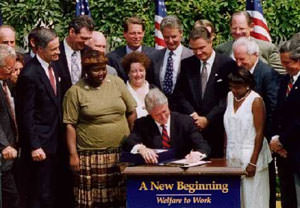Welfare Reform in a Jobless Economy
Although the recession has increased demand for social programs such as food stamps, welfare rolls have not kept pace with the drastic increase in human misery. Long story short: Welfare reform, launched 15 years ago in a booming economy, broke the system … (more)
Although the recession has increased demand for social programs such as food stamps, welfare rolls have not kept pace with the drastic increase in human misery. Long story short: Welfare reform, launched 15 years ago in a booming economy, broke the system, which is not working in a time when jobs are hard to come by.
Your support matters…Miller-McCune:
Reform came with a change in culture, Loprest said, both on the part of state agencies that actively sought to limit enrollment and on the part of would-be participants, who shied from the stigma of public assistance and the declining value of its benefits. Assistance has remained flat since 1996, meaning it’s now worth less in inflation-adjusted dollars.
In 1996, more than 80 percent of families eligible for the program enrolled in it. By 2005, that figure had fallen to 40 percent. In some states, the caseload decline during the recession has simply been an extension of that trend. The data have varied dramatically by state, as welfare reform’s new block grant formula gave individual states much greater control over how they operate the program. In 2009, 80 percent of poor families in California participated. In Texas, 8 percent did.
Independent journalism is under threat and overshadowed by heavily funded mainstream media.
You can help level the playing field. Become a member.
Your tax-deductible contribution keeps us digging beneath the headlines to give you thought-provoking, investigative reporting and analysis that unearths what's really happening- without compromise.
Give today to support our courageous, independent journalists.





You need to be a supporter to comment.
There are currently no responses to this article.
Be the first to respond.